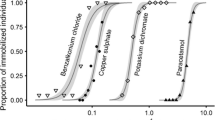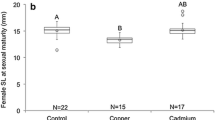Abstract
A mathematical model widely applied in population studies and in assessment of the impact of exploitation on fish populations was applied to assess cadmium toxicity in laboratory populations ofDaphnia galeata mendotae. Over a range of toxicant concentrations, the birth rate of the population increased to balance the death rate and the population compensated for the increased mortality. The model describes the relation between toxicant concentration, toxicant-induced mortality, and equilibrium population size. Compensation for increased mortality is described in terms of the decrease in population size necessary to produce an increase in the birth rate that will balance the increased death rate. The relative capacity of different aquatic organisms to compensate for toxicant-induced mortality is examined and a relation between compensatory capacity and the innate capacity for increase is developed.
Similar content being viewed by others
Literature cited
Allan, J. D. 1976. Life history patterns in zooplankton.American Naturalist. 110:165–180.
Beddington, J. R., and R. M. May 1977. Harvesting natural populations in a randomly fluctuating environment.Science 197:463–465.
Bertram, P. E., and B. A. Hart. 1979. Longevity and reproductionDaphnia pulex (DeGeer) exposed to cadmium-contaminated food or water.Environ. Pollut. 19:295–305.
Birch, L. C. 1953. Experimental background to the study of the distribution and abundance of insects. I. The influence of temperature, moisture, and food on the innate capacity for increase of three grain beetles.Ecology 34:668–671.
Clark, C. W. 1973. The economics of overexploitation.Science 181:630–634.
Fenchel, T. 1974. Intrinsic rate of natural increase: The relationship with body size.Oecologia. 14:317–326.
Frank, P. W., C. D. Boll, and R. W. Kelly, 1957. Vital statistics of laboratory cultures ofDaphnia pulex DeGeer as related to density.Physiol. Zool. 30:287–305.
Jensen, A. L. 1971. Response of brook trout (Salvelinus fontinalis) populations to a fishery.J. Fish. Res. Board Can. 28:458–460.
Jensen, A. L. 1972. Population biomass, number of individuals, average individual weight, and the linear surplus production model.J. Fish. Res. Board Can. 29:1651–1655.
Jensen, A. L. 1976. Assessment of the United States lake white-fish fisheries of Lake Superior, Lake Michigan, and Lake Huron.J. Fish. Res. Board Can. 33:747–759.
Jensen, A. L. 1978. Assessment of the lake trout fishery in Lake Superior: 1929–1950.Trans. Amer. Fish. Soc. 107:543–549.
Marchesseault, G. D., S. B. Saila, and W. J. Palm. 1976. Delayed recruitment models and their application to American lobster (Homarus americanus) fishery.J. Fish. Res. Board Can. 33:1779–1787.
Marshall, J. S. 1962. The effects of continuous gamma radiation on the intrinsic rate of natural increase ofDaphnia pulex.Ecology 43:598–607.
Marshall, J. S. 1966. Population dynamics ofDaphnia pulex as modified by chronic radiation stress.Ecology 47:561–571.
Marshall, J. S. 1978. Population dynamics ofDaphnia galeata mendotae as modified by chronic cadmium stress.J. Fish. Res. Board Can. 35:461–469.
McFadden, J. T. 1977. An argument supporting the reality of compensation in fish populations and a plea to let them exercise it.In W. Van Winkle (ed.). Assessing the effects of power-plant-induced mortality on fish populations. Pergamon Press, New York, NY.
McFarlane, G. A., and W. G. Franzin, 1978. Elevated heavy metals: A stress on a population of white suckers (Catostomus commersoni) in Harnell Lake, Saskatchewan.J. Fish. Res. Board Can. 35:963–970.
Pella, J. J., and P. K. Tomlinson. 1969. A generalized stock production model.Inter. Amer. Trop. Tuna Comm. Bull. 13:419–496.
Phelp, J. R. 1957. Sociality and sparse populations.Ecology 38:107–111.
Pianka, E. R. 1974. Evolutionary ecology, Chiron Press. New York.
Ricker, W. E. 1958. Maximum sustained yields from fluctuating environments and mixed stocks.J. Fish. Res. Board Can. 15:991–1006.
Smith, F. E. 1954. Quantitative aspects of population growth. Pages 274–194.in E. Boell (ed.). Dynamics of growth processes. Princeton University Press, Princeton, NJ.
Author information
Authors and Affiliations
Additional information
Work performed under the auspices of the United States Environmental Protection Agency.
Work completed while on sabbatical leave at Argonne National Laboratory.
Rights and permissions
About this article
Cite this article
Jensen, A.L., Marshall, J.S. Toxicant-induced fecundity compensation: A model of population responses. Environmental Management 7, 171–175 (1983). https://doi.org/10.1007/BF01867278
Issue Date:
DOI: https://doi.org/10.1007/BF01867278




